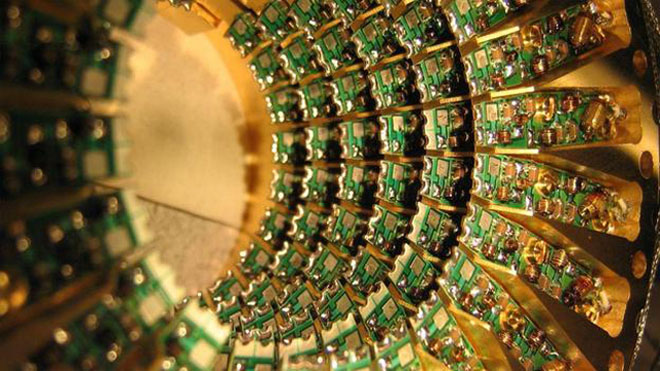
Quantum PCs must defeat the test of distinguishing and amending quantum errors, before they can satisfy their guarantee of filtering through a huge number of conceivable programs much quicker than traditional PCs. With the previous four qubit systems, a framework was constructed that recognized all sorts of quantum errors, stated Jerry Chow, a manager of test quantum computing at IBM’s Thomas J. Watson Research Center, in Yorktown Heights, New York. Mr. Chow, who, alongside his IBM associates published their examinations in the 29th of April, issue of the Nature Communications, says, “This is the first exhibition of a framework that can distinguish both bit-flip errors and phase blunders” that exist in quantum computing systems.
The IBM framework comprises of four quantum bits, or qubits, arranged in a two by two design, on a chip measuring around one point six square centimeter (zero point two five square inch). Every qubit is generally what might as well be called a touch of data, that or a “bit” of information, and represents either one or zero. Like traditional bits, qubits can experience bit flip error that switch the values. Anyway, qubits are additionally powerless against an alternate sort of slip called a – phase error, on the grounds that they take advantage of the quantum physics phenomenon called superposition, that permits them to briefly exist as both one and zero at the same time. A phase error can change the superposition sign of the phase relationship between the one and zero values.
Identifying quantum mistakes is definitely not clear. Like traditional PCs can recognize and correct their bit-flip errors, by essentially duplicating the same bit many times and taking the right value from the most part of error free bits. By correlation, the delicacy of quantum states in qubits implies that attempting to duplicate them can have the counterproductive impact of changing the quantum state. Specialists get around that issue by depending on entrapment, the quantum material science sensation that permits a qubit to impart its quantum state to numerous different qubits through a quantum network. For this situation, IBM assembled its four qubit grid architecture design to endeavor the data shared between trapped, via side by side, qubits. Two of the qubits are the fundamental “information” qubits; the other two exist as “estimation” qubits. One of the estimation qubits can recognize bit-flip lapses in either neighboring information qubit. The other estimation qubit recognizes stage slips in the information qubits.
Image Source: IBM Research – A four qubit architecture
In spite of the fact that IBM’s four qubit framework has effectively recognized both sorts of quantum errors, it can’t yet correct its mistakes. Furthermore, a Google group, including analysts from the University of California, Santa Barbara, beforehand showed the first blunder revision for quantum figuring on the 4th of March, 2015, in the issue of the journal Nature. Google built a framework comprising of a linear array of nine qubits, that likewise utilized both information and estimation qubits to recognize blunders. Such architecture support used surface code for error connections, utilizing normal computing to help amend the quantum problems.
Still, Google’s course of action of qubits in a single line had its own particular disadvantage: The framework could not distinguish both bit-flip and phase blunders at the same time. However, IBM’s 2D framework, that consists of four qubits, has indicated how it recognized both quantum errors. Google engineers and technicians show similar desires of building a 2D cluster of numerous qubits, organized in a checkerboard design, so that it could deal with both sorts of quantum errors. Both IBM and Google have constructed their quantum processing architectures in view of superconducting quantum circuits. These architectures speak to qubits as Josephson intersections, two layers of superconductor separated by a thin protecting layer. Superconducting qubits may have an edge over opponent quantum processing architectures, in light of the fact that they can be produced utilizing a significant number of the current instruments utilized in building traditional PCs. This could make it simpler to scale up to huge quantum systems with numerous qubits.
Chow and his IBM buddies, have already started exploring different ways of regarding an eight qubit cluster. They, in the end, would like to fabricate arrays with thirteen to seventeen qubits on a side, which would be sufficiently expansive to encode a single logical and intelligent qubit, that would be free from errors. For the time being, both IBM and Google appear to be sure that the superconducting qubit architecture can scale up well into what is to come. Their error detection’s and error redress endeavors are laying the path for bigger quantum processing frameworks that could surpass established PCs in tackling certain issues, and do so dependably. “A considerable measure of enthusiasm for quantum computing originates from seeing the end of the passage with Moore’s Law. Presently we are seeing what potential lies beyond,” says Chow.
You want to support Anonymous Independent & Investigative News? Please, follow us on Twitter: Follow @AnonymousNewsHQ
Source: Science Daily Fossbytes CNET






something bad’s gonna happen…
Like terminator-bad event….
You know that the Mariana web needs a quantum computer to be accessed. The Mariana web contains the worlds most secret secrets. If this information goes into the wrong hands… Well. Guess you understand what Im trying to tell you.
I hope They could solve woman
Marina’s web ???